I’m sure most of you are familiar with Buffer, the tweet scheduling app that evolved into a social media scheduling app. Now the tool is viewed as a necessity, not only for startups, but for every business which aspires to do great content marketing and build a tribe for itself. With a yearly income of nearly $4 million, Buffer managed to become one of the best platforms to schedule, analyze and create social media strategies on all social media websites including Facebook, Twitter, Google Plus and LinkedIn.

What follows below is the reverse engineering of Buffer’s digital marketing strategy. We’ll try to uncover what strategy they used as a new startup and how they adapted it while growing their company and becoming a necessity for digital marketing agencies around the world.
1. The BufferApp Story
Just like many other startups, the story starts in the college rooms of the United Kingdom, in which Leo Widrich and Joel Gascoigne set the building blocks of Buffer. Joel writes the code for the twitter scheduler and soon after that tells Leo about it. The idea seemed great to both Leo and Joel and so the partnership began. The marketing side of the business would fall in the hands Leo Widrich.
Being new to marketing, Leo started using content marketing as a way to promote the business. Buffer focused on blogs and social media with its marketing efforts. The first step was to gain an audience and win some notoriety for their tool.
Buffer was pitched to the top tech blogs like Mashable, TechCrunch but nobody wanted to write about them.
Moreover, even blogs with a smaller audience declined to talk about the newly created tool.
“Okay. Let’s set up the Buffer blog. Let’s write about interesting things that are in the social media space so people find it interesting […]” – Leo Widrich
As a result, Leo started to produce the content on his own and publish it on their newly created blog. During the first 10 months he wrote about Twitter, how to get more followers and how Twitter could be used for SEO purposes. He then started publishing with a frequency of 2-3 articles per month, but soon wrote 3-4 articles each week. After he produced some great pieces of content he reached out to other blogs and asked if their audience would be interested in similar articles.
He started creating relationships. He gained their audience through guest blogging and after 10 months, Buffer had over 100,000 users.
“We then, from the U.K., moved to Silicon Valley. Half a year later raised the seed round from some great angels in the Valley, and I dropped out of college. My parents weren’t very happy about it.” – Leo Widrich
The shift of the content strategy appeared when they integrated other social media platforms like Facebook and LinkedIn within their tool. Their content marketing turned away from Twitter and started writing content about social media marketing and its uses. They tackled topics such as how to make Google plus work for you and what works best on Facebook. The biggest switch in content marketing tactics came with the publishing of the content marketing manifesto by Rand Fishkin. The manifesto pushed one thing:
Instead of creating your content for potential customers, create it for influencers who are already reaching them.
This switch in tactics was remarked on the Buffer blog. More business, more efficiency and overall more fun articles started appearing. Their average 250 tweets per article quadrupled and reached 1000 with this switch and their successful content strategies.
They wanted to influence the influencers and they managed to do just that.
Let’s take a more in-depth look at how their startup became a multi-million dollar business:
2. The BufferApp SEO Strategy
Buffer didn’t use a traditional form of link building in order to reach the success they encounter today. What they’ve done is pure organic growth through content marketing and growth hacking. In this chapter we’re going to reveal the SEO metrics related to the digital marketing strategy in which Buffer has engaged.
2.1 Understanding the SEO Visibility
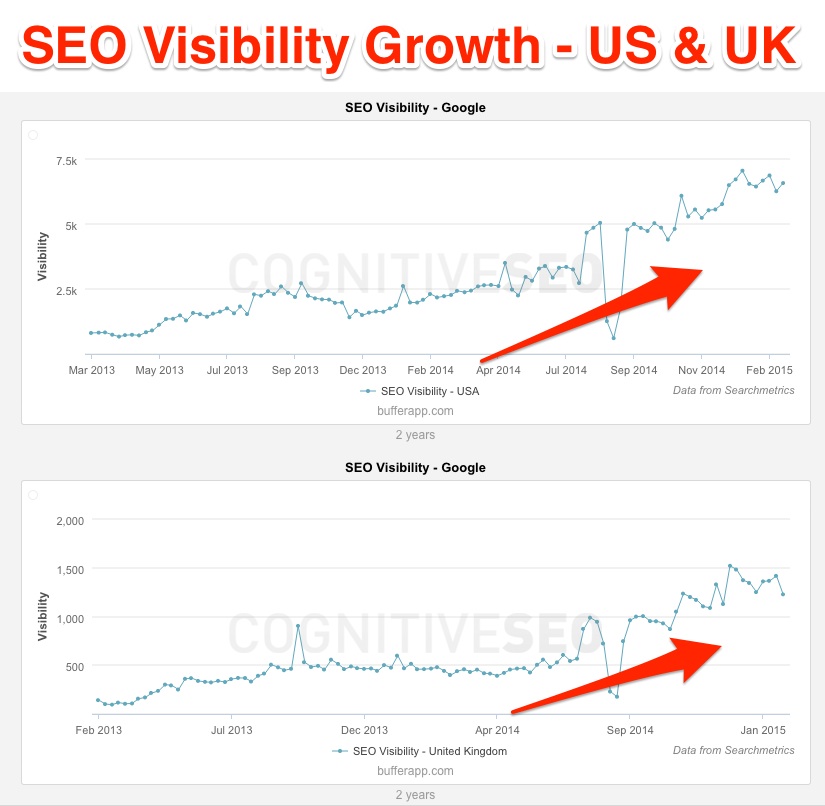
Looking at the data from cognitiveSEO, we can see the result of a well executed long term strategy. A slow but steady growth in the seo visibility, and once it took off in June 2014, the growth was exponential. The visibility drop you can notice in September in the SEO Visibility was from a “hasty” switch from HTTP to HTTPS, together with a manual penalty received from Google. They have recovered quite quickly from it seems. Other than that, the growth was constant, and the recovery was quick. The increased SEO Visibility from June is owed to the switch in content marketing strategy and expanding the topics that Buffer usually wrote about till then.
2.2 Digging the Alexa Visibility
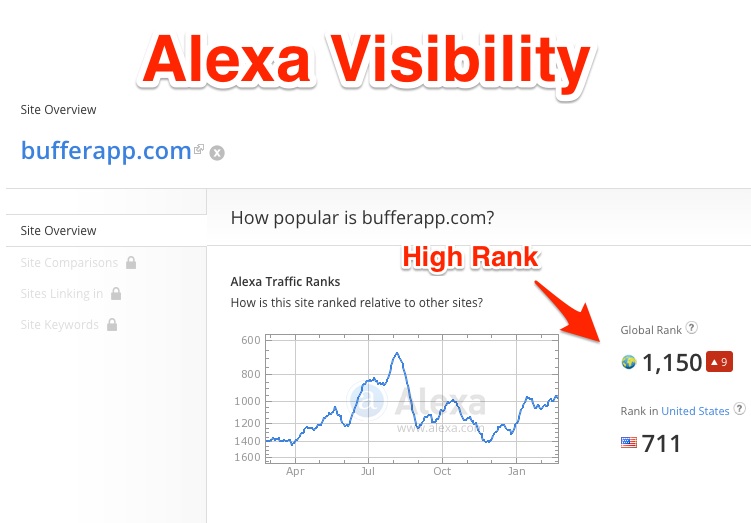
The Alexa rankings metric represents an estimate measure of a website’s rank, compared with others from the internet. In the Buffer case, the Alexa chart mirrors the one from the social visibility chapter, with a huge spike in June and the drop in ranks in the month of September.
For their tool, which targets worldwide users, having a rank of 1,150 means they are really doing well. Once again we notice the increase in global rank in June and I have to mention that not only the content marketing switch helped gain more visibility in the SERPs, but it also increased the Alexa ranks.
It’s important to keep in mind that the Alexa Traffic tool can sometimes be way off in its results, as it gathers data only from the users using the Alexa toolbar.
2.3 What Keywords Does Buffer Rank on?
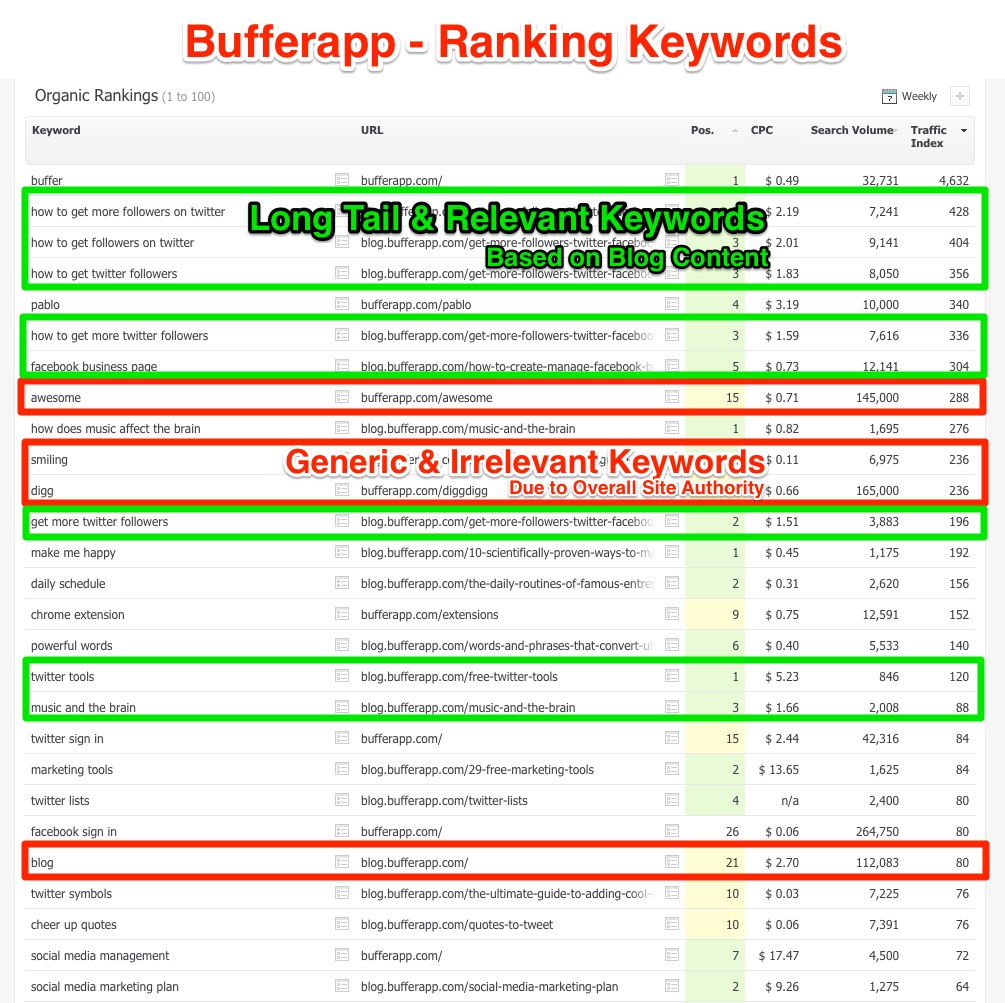
A characteristic of using content marketing to promote your business is ranking well for long and relevant keywords. As you can notice in the chart above, most of Buffer’s high ranking keywords are pointing to blog articles. This is a good metric to take note of when you want to follow the success of the content marketing strategy.
The irrelevant keywords that appear in the chart are due to the site’s overall authority. Buffer’s authority increased and started ranking for keywords they weren’t necessarily focusing on. This just adds to the success of their content marketing strategy and allows them to spread their content to a wide variety of topics since the site’s authority is already established.
2.4 A Mystic Google Penalty

Screenshot from open.bufferapp.com/august-content-report/
The drop in SEO Visibility mentioned above came from a hasty switch of their social blog from HTTP to HTTPS combined with a manual Google penalty. The decision to make the switch came after Google announced that they will take into consideration the security of the website and the use of HTTPS over HTTP. Their desire to quickly jump on the bandwagon led to some mistakes. Moreover, they didn’t catch the mistake just in time and they managed to lose a large portion of organic traffic. Buffer also received a manual penalty warning in the Google Webmaster Tools but no further details were given about it.
They did fix the issue with the HTTPS and mentioned that with the help of John Mueller (Webmaster Trend Analyst at Google) and his team, Buffer also recovered from Google’s penalty.
For the moment Google deems HTTPS as a lightweight ranking factor, affecting about 1% of the websites, but in the future we may expect the factor to become heavyweight.
2.5 Link Building Strategy – Shady or Not?
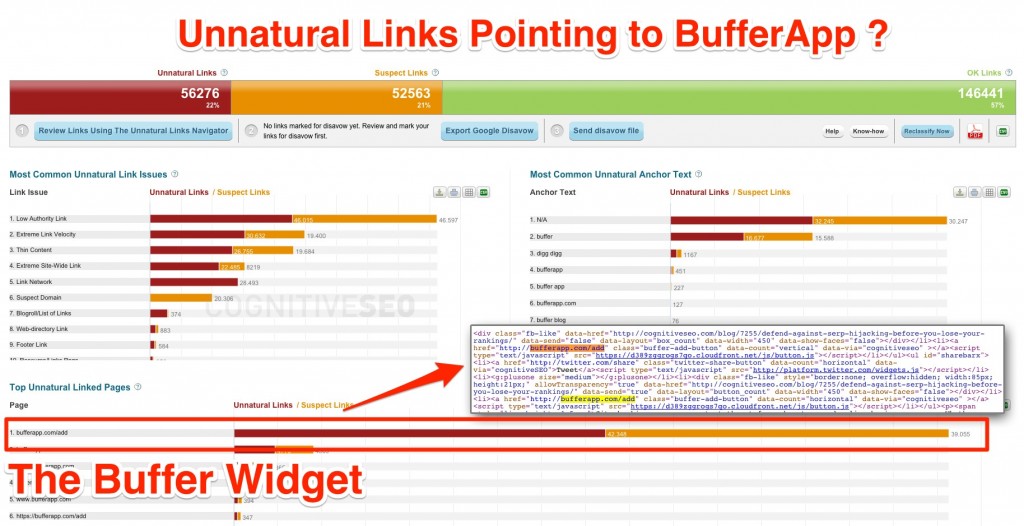
Looking at the backlink profile, Buffer seems like it’s not doing so well in terms of link health. Over 22% of links pointing back to it are unnatural. This could have caused a penalty from Google and a huge loss in organic traffic. The SEO Visibility chart did show a drop in rankings and it could have been from the manual penalty mentioned above together with the hasty switch from HTTP to HTTPS.
The links are coming from the Buffer Widget and they are all pointing to the “/add” directory.
Google did state that links inserted in widgets are a big no no, and that’s why our tool marked the links as unnatural.
We can assume that the links are from blogs which have social widgets installed on them.
But that Page is NoIndexed by Robots.txt so No Influence on Rankings.

We can see how they worked around another Google penalty. With the help of the robots.txt file, Buffer asked Google and other web crawlers not to index that directory on their website. By doing so, Google won’t index the links and it will not consider the links to be unnatural. The Google penalty would have been triggered and their organic traffic would have hit rock bottom. Those lines in the robots.txt file really saved them.
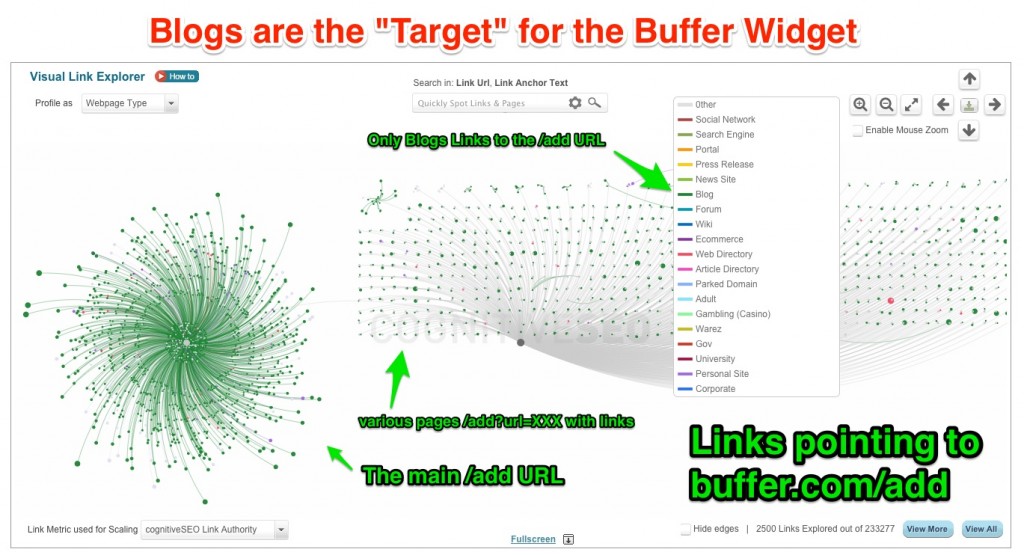
It was really smart of them to point the widget only to one directory on their website. This way, they could easily block the indexation of the directory in the robots.txt file.
Link Building Strategy = Relationship Building
Looking at the overall backlink profile, link gain velocity and overall SEO strategy, we can say that Buffer didn’t really use a traditional Link Building Strategy. They seemed to understand that link building switched from hunting for links in web directories and blog post spam, the unnatural one, to a more organic strategy. They used a new link building mentality:
Link Building Mentality – Create relevant & engaging content in order to build a reputation in the community, and get your site linked.
3. What’s Their Content Marketing Strategy
After we uncovered Buffer’s SEO strategy, we can notice that the overall marketing efforts for Buffer are focused on content marketing. In the following chapter we’ll take a more in-depth look at their content, its target and the behavior of Buffer’s readers.
3.1 It All Started with Guest Blogging

Buffer’s content strategy started with a few posts on their blog and more social outreach to other high authority blogs and magazines. They used guest posting as a way to build awareness and authority for their own website, so that in the future, once they gained the trust of readers, they could focus more on their own website. In the chart above, we notice that today the main sources of links are from “blog posts or forum threads” and “short paragraph of text”. Buffer successfully managed to create conversations to build awareness for their application.
3.2 Guest-posting to Buffer’s Blog Posting Transition
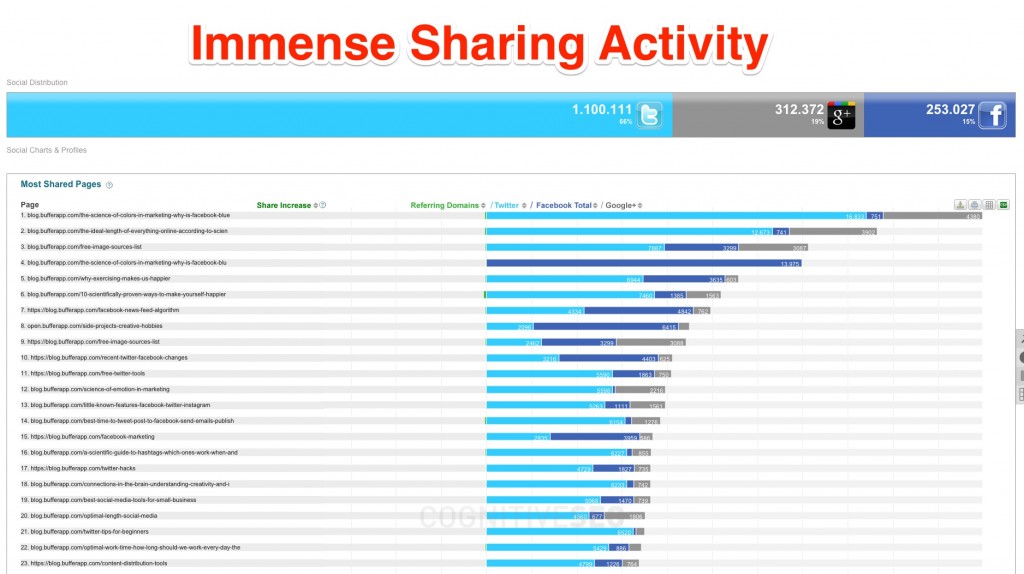
After they gained a lot of traction with guest blogging and starting online relationships, they focused more on their own blog. Buffer had huge success with their articles, especially on Twitter. Some of their blog posts reached more than 20,000 people. And to note is the fact that they reached the right people, relevant to their business.
Nowadays their articles have an average of 4,000 twitter shares with an occasional spike of 7,000 or 8,000. They managed to create a “social following”, a tribe that engages with Buffer at every article they write.
3.3 Number of Authors and Post Frequency
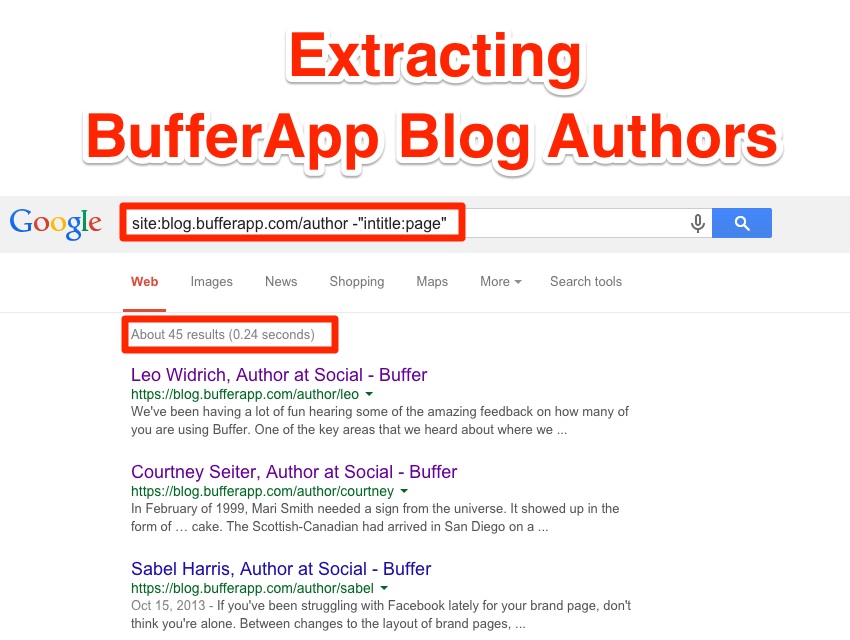
Finding out the exact number of authors who wrote on a website can be easily done with a simple Google query.
Using the “site:blog.bufferapp.com/author-“intitle:page” query, the SERPs will display all the pages in the author directory.
As mentioned in the introduction, for the first 10 months it was only Leo Widrich, the co-founder of Buffer, who wrote on the blog. As they grew more and more and reached a larger audience, more writers were co-opted for their business. We managed to find that 45 writers blogged for Buffer. These ones certainly helped to produce great pieces of content and expand the Buffer audience.
Seeing the evolution of the blog through time, we can notice the frequency of posting has increased significantly. In the first 10 months the Buffer blog published an average of 2-3 articles each week. Next it increased to 4-5 each week and nowadays they publish almost daily. And this is only on their own blog. Leo Widrich stated that in the first nine months he wrote around 350 articles, 3 to 4 articles each day, and tried to get them published on different websites.
3.4 What Kind of Content Does Buffer Publish
The types of content published on the buffer blog also changed as time went on. It had two important switches throughout time. I did mention above that initially the blog content focused on articles about Twitter. Being a Twitter scheduler app it was Buffer’s way of creating a reliable and relevant tribe.
The first switch appeared with the integration of Facebook and LinkedIn in the scheduler. The blog focused then on a variety of topics from the social media world. This isn’t to say that other Twitter articles weren’t published, but the authors also tackled some business development and growth on social media topics as well.
The last content switch happened with the publication of the Content Marketing Manifesto. This made Buffer’s writers to target influencers also, rather than only relevant users. The topics now were more focused on business, psychology and overall light topics. This quadrupled the social response, articles that usually averaged 250 twitter shares, managed to reach 1,000.
3.5 What Kind of Content Works Best for Buffer
In each business segment it’s best to tailor the content to fit a certain persona. Once this is achieved, further tweaks and adjustments can be added to make the content fit each of the main social platforms. Let’s take a look at what kind of content works for each social platform for Buffer:
For Twitter

The most shared articles on twitter are:
- The Science of Colors in Marketing Why is Facebook Blue – with over 16800 twitter shares. An in-depth article with more than 1300 words written by Leo Widrich. The article is rich in studies about established brands, color psychology and a/b testing.
- The Ideal Length of Everything Online According to Science – around 13000 twitter shares. Another in-depth article written by Kevan Lee, in which he lists the perfect length for posts on each important social media platform.
- Free Image Source List – around 7000 twitter shares. Announcement article for a free tool made by the Buffer team.
- 10 Scientifically Proven Ways to Make Yourself Happier – around 7000 twitter shares. One of the articles that appeared after the switch to content that targets influencers.
We can extract from these data the fact that in-depth analysis articles do really well on Twitter.
Let’s take a look at what content works best for Facebook:

The best 4 Facebook articles are:
- The Science of Colors in Marketing Why is Facebook Blue – Around 14,000 Facebook shares. The same article that leads the activity on the Twitter platform worked best for Facebook too.
- Science of Side Projects – With almost 6,500 Facebook shares. An in-depth article presenting how hobbies and side projects can improve overall performance.
- The Journey from ‘Crafters’ to ‘Traction’: Buffer’s October Marketing Report – Around 5,000 Facebook shares. Marketing report, detailing the status of Buffer’s marketing efforts in the months of September and October.
- Recent Twitter Facebook Changes – With 3700 Facebook shares. In depth article about Twitter and Facebook changes.
We can see that for Buffer’s market, the same in-depth content that works on Twitter, also works well on Facebook.
We can start to draw a conclusion but let’s analyze the Google Plus activity before it:
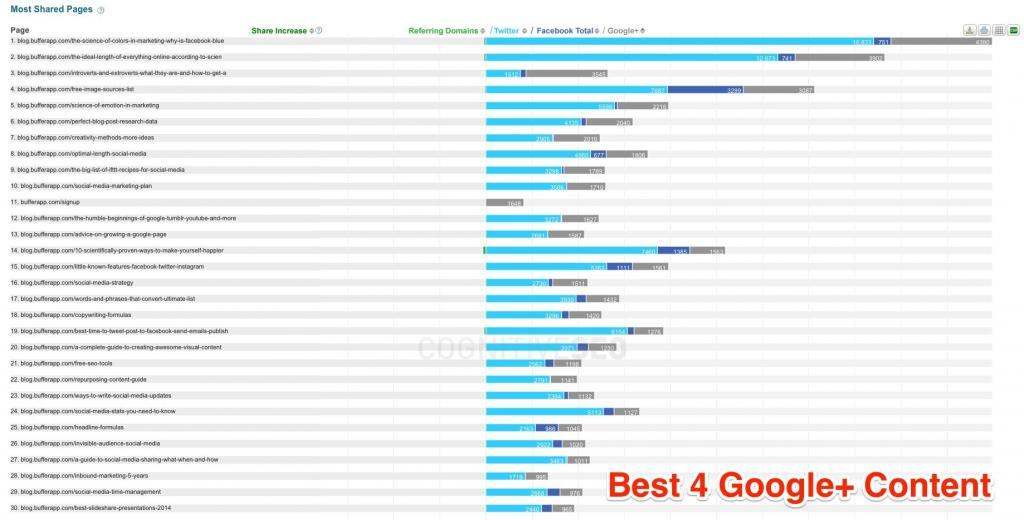
The best 4 Google Plus articles are:
- The Science of Colors in Marketing Why is Facebook Blue – This article had close to 4,000 Google Plus Shares. The same article that leads the activity on Twitter and Facebook
- The Ideal Length of Everything Online According to Science – Around 3,000 Google Plus shares. An in-depth article presenting how hobbies and side projects can improve overall performance.
- 22 Tips To Better Care for Introverts and Extroverts – With 3,500 Google Plus shares.A very successful in-depth article on Google plus platform and not on many others.
- Free Image Source List – With 3,000 Google Plus shares, this article is announcing a free tool made by the Buffer team.
In-depth and long articles work really well for Google Plus too. They clearly have found what their audience was looking for and know how to use that.
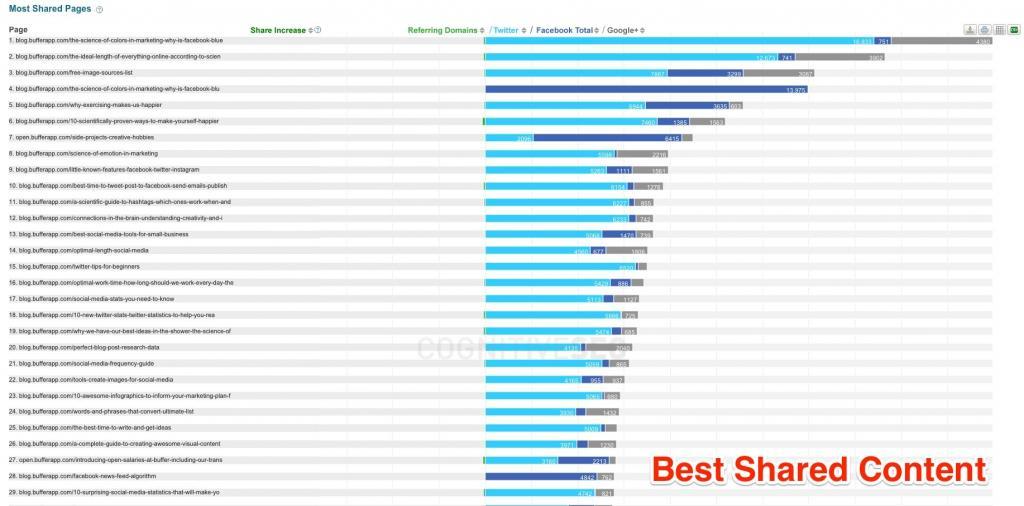
The overall conclusion for what kind of content works for Buffer is that long and in-depth well researched articles generated more traction on the social media platforms.
There isn’t too much of a difference between the behavior of the fans on different social media platforms, they all enjoy reading and sharing the same content. A fact that is also clear to see in the chart above which shows the overall social media activity on Facebook, Twitter and Google Plus combined.
3.6 Social Signals vs. Links Correlation
When a company engages in a content marketing strategy it has a variety of metrics to follow: the social traction a piece of content generates, the amount of backlinks the articles produce and even the comments produced for each piece. Each of these metrics is worth following individually but when you have multiple data points from each one you can study how they correlate on each social platform.
Let me first explain what the charts below represent. It’s a correlation between the social media activity for a blog post and the amount of links pointing to that article. It’s a very important metric to study in order to find out if the increased social sharing leads to gaining more backlinks for the website. The data are also used to see which type of content generates more backlinks and which type of content generates the most traction in social media.
On the following chart, the dots represent each article shared through Twitter, and on the x axis the amount of referring domains that particular article is linked from. Let’s study the Twitter share vs. referring domains first:

The graph shows a moderate positive correlation between the number of tweets and referring domains, meaning that a large amount of Twitter shares will lead to a large number of referring domains gained. Let’s look further at the Facebook activity and see if the social activity there will lead to more backlinks:

Even if there is not such a strong correlation between the Facebook activity and the number of referring domains, a large amount of sharing will still result in a large amount of referring domains gained.

The same can be said here, for Google Plus. Just like the other social media platforms, the large amount of shares on Google Plus will lead to a large number of referring domains.
Overall we didn’t notice one social media standing out too much from the other for the correlation between social shares and referring domains gain. Twitter seems to take the lead in terms of social share to referring domains gain, but only by a small amount. Buffer continues to use them all at the same intensity, since neither one of them will generate more backlinks than the other.
4. Growth Hacking Strategy – Tricks Used
For every startup, including Buffer, getting the name out there and creating a user and fan base is one of the most difficult challenges. In order to compete with established brands through traditional methods it will take a lot of effort and the results will appear late. Buffer knew this and they got creative with their growth strategy.

Studying the Visual Link Explorer chart, it seems clear which market Buffer targeted. Let’s take a closer look to see exactly which niches provided the best results for their marketing efforts.
4.1 The Most Important Niches That Use Bufferapp
In order to figure out the growth strategy for Buffer we have to take a look at which category of websites link back to the app. Let’s try to find out which niches worked best for Buffer:
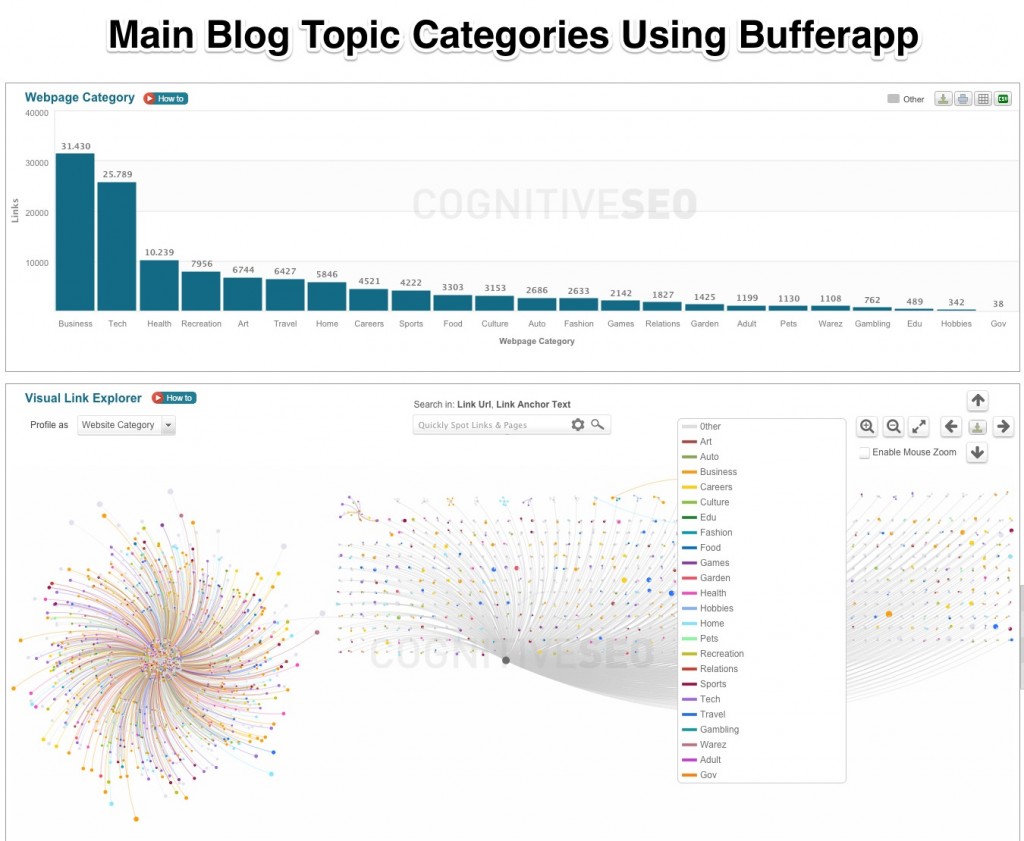
The chart displays the niches that use the Bufferapp widget. It seems that there is a lot of use of the tool in the business and tech blogs. According to Google, these two categories represent a total of 2 million blogs online at this moment. This growth strategy is all about focusing on those categories in which a large deal of influencers lie. Once they have been reached and converted, the growth of Buffer was almost exponential as we saw in the Social Visibility chart.
4.2 Freemium Model
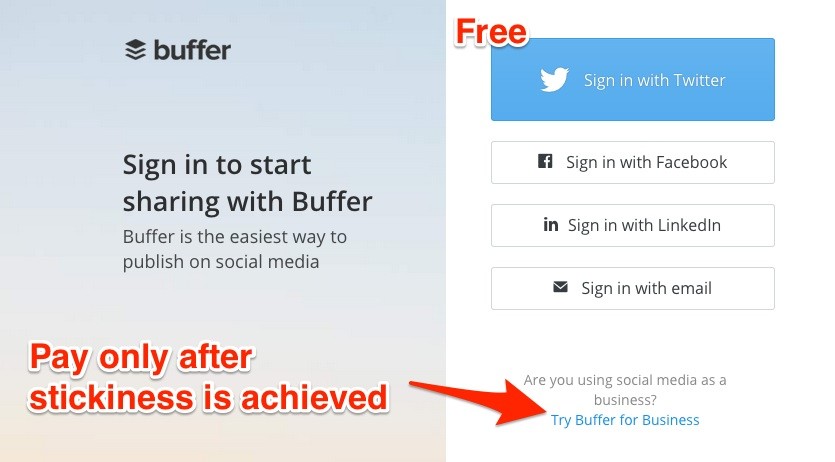
The next growth strategy used by Buffer was the Fremium business model. This strategy is described as offering the service free of charge, but with a cost (premium) for extra features and functionality. It’s a great and easy way to implement growth hacking strategy since it makes the tool its own advertising platform. To clear this out, the more users use the tool, the more see it and, in turn, will use it and so on. Among the free users, many will find use of the premium features on the tool, and will pay for the extra functionality it provides. This worked great for them since the buffer app appeared on the users blogs and websites generating more awareness for the tool.
4.3 The Buffer Blog Widget – A Neat Growth Hacking Trick
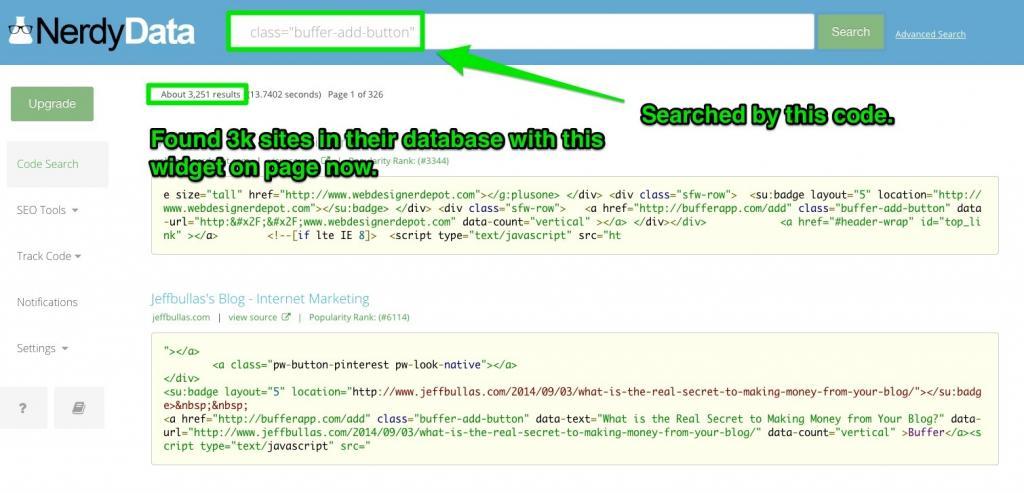
NerdyData’s data provide some interesting insights, by searching for the buffer add button code in their search engine, the tool uncovered almost 3,000 websites in its database. So 3,000 websites which have the bufferapp, and which have a link pointing back to the buffer page. That’s one way to build unnatural links, but as mentioned above, they used the robots.txt file to disable GoogleBot from indexing the directory the link is pointing to.
Let’s take a look at how that reflected in the link gain velocity:

After introducing the link into their widget, Buffer received a huge increase in their monthly link velocity. We can track in the backlink explorer exactly how many websites add their app each month.
4.4 Growth Hacking Idea – An Internal Traffic Booster both for Them and Others
One other interesting growth hacking strategy that they use is done with the help of the suggestion tab in their tool. The suggestion tab does exactly what it says, that is to offer a variety of articles that have been shared on that day and in that industry. Having their content strategy tackle many other topics, besides social media and business, Buffer is able to promote its own blog posts inside their own tool and still be relevant to the industry the user is in.

Take a look at how it works. The user checks what content is recommended for him, filters the topics and picks what’s interesting to the users’ fan base. Most of the time, you will be able to find a Buffer blog post in the suggestion boxes. It’s an interesting and creative way to promote their own business, with the help of the tool they are marketing.
Inception – Buffer helps Buffer promote itself!
An extra incentive to install the Bufferapp on your website is the fact that only this way you’ll have your content available in the suggestions section of the app.
4.5 API and Data Integrations as Growth Hacking Tools

What’s important to understand when using or creating an API is to make it in such a way that when it is used to build widgets or other apps, it will automatically bring more content into its own network. The API is there to make the core service, in this case the bufferapp, stickier to the users, even though it’s used through a third party software. Buffer’s API is very focused towards the end user, the developer in this case, and it provides him with a full documentation and tools needed for a more easy integration of the bufferapp within its newly developed app or widget.
By using the API as a growth hacking strategy, Buffer enabled other developers to make their own marketshare, use the bufferapp. And since the Bufferapp’s success is determined by the number of users who are active, they managed not only to get more people to use its core service, but also increased the overall size of the marketplace.
Conclusion
Buffer’s success is owed to a well established marketing strategy of making content that is great, engaging, and most of all, worth sharing. They managed to create a tribe that engages with them on all social platforms and is eager to reply and share each new piece of quality content that they deliver. Buffer managed to find the right combination of content marketing, growth hacking and together with a really good product they became an almost irreplaceable tool.
They understood that marketing results will not provide overnight success and chose a natural way to grow their business. They owe most of their success to a great content marketing strategy.
What we want you to take from this article is the following:
- Focus on building great, engaging and shareable content.
- If your content is great, it will gain its own links naturally.
- Reach out and engage with influencers, since they can bring their own tribe to your product.
- Have patience and remember that you are engaged in a long term plan. Don’t expect results overnight!
- Always test out new content pieces. See what works best for your readers, and what works best for each social media platform.
- Get as creative as you can with the growth hacking strategies. Try to make your product stick and be hard to replace for the end user.
What other facts can you extract from the Buffer’s success analysis? Have you tried any of the tactics listed above and how did they work out for you in the end?

 Site Explorer
Site Explorer Keyword tool
Keyword tool Google Algorithm Changes
Google Algorithm Changes

Stellar post here Razvan! I’ve been a huge fan of Buffer for awhile now and this is certainly the most in-depth piece I’ve written about the workings on how their content marketing strategy has succeeded the way it has. It’s easy for people to look toward Leo and his stellar team of content creators as talented/smart writers and call it at that, but your post has done a great job of showing the subtle, sharp product/SEO decisions they made over the years.
Thanks for writing this!
😉 glad u found it useful
Great insights here Raz! Thanks a bunch for giving the time and effort to produce this wonderful content. I’ve read the story of Buffer and it really inspires me to think more than what is expected of me. Definitely, people on top of the chain, think differently.
Got to add this to my tweet scheduler. 🙂
I simply want to say I’m very new to blogs and actually loved you’re blog site. Almost certainly I’m going to bookmark your blog post . You absolutely come with great well written articles. Thanks a lot for sharing your blog.
Thanks for sharing this Inspiring post!
It would provide a roadmap for devising our digital marketing Strategy.
I read this post fully regarding the comparison of
newest and earlier technologies, it’s amazing article.